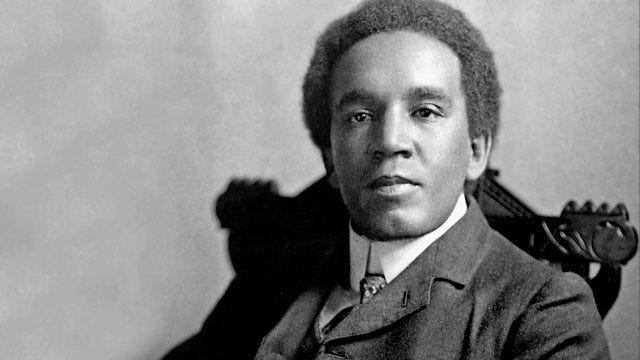
Samuel Coleridge-Taylor was born in London in 1875. Coleridge-Taylor was raised by his mother and his grandfather, who taught him to play the violin. He quickly took to the instrument and was admitted at age 15 to the Royal College of Music. He switched from violin to composition and studied with the highly esteemed Charles Villiers Stanford. After graduation, he became a professional musician and was soon hired to be a professor at Crystal Palace School of Music as well as the conductor for the Croyden Conservatoire.
Edward Elgar who described Coleridge-Taylor as “far and away the cleverest fellow going amongst the younger men,” recommended him to the Three Choirs Festival 1896 and his wonderful orchestral piece Ballade for orchestra, Op.33 was premiered there in 1898.
Coleridge-Taylor’s Hiawatha’s Wedding Feast was composed in 1898, directly following the successful premiere of his Ballade. The premiere on November 11, 1898 was the event of the season. An elderly Sir Arthur Sullivan made it a point to see the premiere and wrote, “Dined at home and went to Roy. Coll. Music Concert to hear Coleridge-Taylor’s Hiawatha. Much impressed by the lad’s genius. He is a composer, not a music-maker. The music is fresh and original — he has melody and harmony in abundance, and his scoring is brilliant and full of colour — at times luscious, rich and sensual. The work was very well done.”
Like so many around the world, he was greatly inspired by Longfellow’s 1855 poem, The Song of Hiawatha — he even named his son, Hiawatha — and Hiawatha’s Wedding Feast was the first of what would become a trilogy of works. However, the second and third movements, The Death of Minnehaha and Hiawatha’s Departure never reached the fame of the first movement, a piece that would be played around the world. In fact, Coleridge-Taylor was such an international sensation that by1904 he was received by Theodore Roosevelt at the White House.
African Americans greatly admired Coleridge-Taylor and he made three very successful tours of the United States, meeting and befriending W.E.B. Du Bois, and collaborating with the poet Paul Laurence Dunbar, setting many of Dunbar’s poems to music. Here’s a beautiful performance of How Shall I Woo Thee.
His love for the United States was profound and he seriously considered moving here and his works began to explore his own Creole and African heritage. His incredible orchestra piece from 1910, The Bamboula, Rhapsodic Dance for orchestra Op. 75, describes in music the popular 18th century Haitian dance that would eventually find its way to Alabama and Louisiana.
And Coleridge-Taylor’s Twenty-Four Negro Melodies, Op. 59 are unmatched in their power and depth.
In 1906 he composed Symphonic Variations on an African Air, Op.63. A piece every orchestra should perform.
In 1912, Coleridge-Taylor composed his Violin Concerto in G minor, Op. 80 for the great American violinist Maud Powell. It is a piece that needs to be heard far more often!
A piece that was often performed in the early part of the 20th century that occasionally still resurfaces is Coleridge-Taylor’s Petite Suite de Concert, for orchestra Op. 77.
Considering how prolific he was, it is remarkable that Coleridge-Taylor was only 37 when he died in 1912. And even though Hiawatha’s Wedding Feast was known world-wide and had sold hundreds of thousands of copies, Coleridge-Taylor did not receive any remuneration aside from the initial sum of 15 guineas he received. In fact, his death and poverty was the catalyst for musicians to create the Performing Rights Society in England.
I encourage you to watch this excellent two-hour documentary on Coleridge-Taylor’s influence in America.
